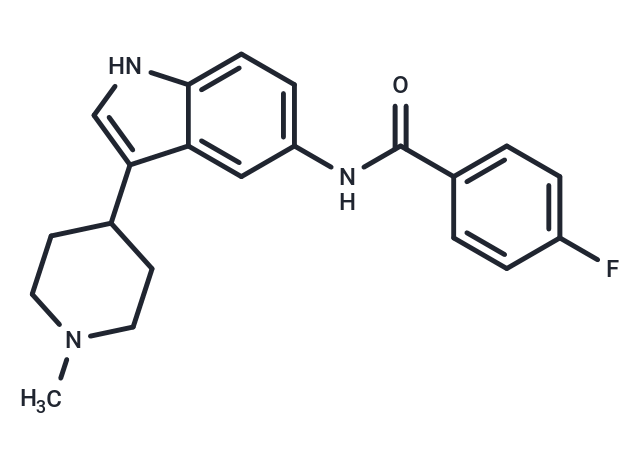Shopping Cart
- Remove All
 Your shopping cart is currently empty
Your shopping cart is currently empty

LY334370 is a selective 5-HT1F receptor agonist with a Ki of 1.6 nM

| Pack Size | Price | Availability | Quantity |
|---|---|---|---|
| 5 mg | $38 | In Stock | |
| 10 mg | $59 | In Stock | |
| 25 mg | $133 | In Stock | |
| 50 mg | $197 | In Stock | |
| 100 mg | $287 | In Stock | |
| 200 mg | $397 | In Stock | |
| 1 mL x 10 mM (in DMSO) | $43 | In Stock |
| Description | LY334370 is a selective 5-HT1F receptor agonist with a Ki of 1.6 nM |
| Targets&IC50 | 5-HT1F:Ki: 1.6 nM |
| In vitro | LY334370 does not exhibit vasoconstrictor effects on human cerebral arteries in vitro at doses up to 10^-5 M, where it induces a minor contraction of 8.5±5.7%; this effect is not considered significant. |
| In vivo | Following intravenous administration of LY334370 at doses of 3 mg/kg (n=3) or 10 mg/kg (n=6), electrical stimulation induced increases in dural blood vessel diameter by 135±6% and 106±11%, respectively, with no significant difference from control values. LY334370 does not independently affect dural blood vessel diameter, as measurements remained consistent at 43±4 arbitrary units both before and 15 minutes after a 10 mg/kg dose injection. |
| Kinase Assay | AlphaScreen Assay: All reagents are diluted in 50 mM HEPES, 0.1% BSA, pH 7.5 supplemented with 0.01% Tween20 and allowed to equilibrate to room temperature prior to addition to plates. Catalytic turnover assays are run in 10 μL volumes in lowvolume 384-well plates at RT. The reaction consisted of enzyme (5 nM), biotinylated substrate peptide (30 nM), Fe(II) (1 μM), ascorbate (100 μM), 2OG (10 μM) and run at RT. For PHD2, the reaction consisted of enzyme (5 nM), biotinylated substrate peptide (60 nM), Fe(II) (20 μM), ascorbate (200 μM), 2OG (2 μM) and run at RT. EDTA is used to quench the reaction (5 μL), AlphaScreen donor (Streptavidin-conjugated) and acceptor (Protein A-conjugated) beads preincubated with peptide product antibodies are added (5 μL). Plates are foil-sealed to protect from light, incubated at room temperature for 60 minutes and read on a PHERAstar FS plate reader using an AlphaScreen 680 excitation/570 emission filter set. The final bead concentration in 20 μL reaction is 20 μg/mL. IC50 values are calculated in Prism 6 after normalisation against corresponding DMSO controls. |
| Cell Research | For in vitro studies, LY334370 is dissolved in buffer solution.Human cerebral artery is used in this study. Segments are prepared as previously described, but briefly they are placed in a buffer solution containing (mM) NaCl 119, NaHCo3 15, KCl 4.6, CaCl2 1.5, NaH2PO4 1.2, MgCl2 1.2, and glucose 5.5. Sections of vessel about 0.5 mm in diameter and 1 to 2 mm in length are mounted in a temperature-controlled tissue bath (37°C) containing buffer solution bubbled with 95% O2 and 5% CO2. The vessel segments are given a tension of 4 mN and allowed to stabilize at this tension for 1 to 1.5 h. Vessel reactivity is tested by exposure to 60 mM KCl. This is done twice for each segment and only if the response is similar to the segment used for LY334370 testing. Responses to LY334370 is calculated as a percentage of the maximum KC1 response. |
| Animal Research | LY334370 is dissolved in 0.9% saline and is administered at a volume of 1 mL/kg. Male Sprague-Dawley rats (300 to 400 g) are treated with LY334370 (3 or 10 mg/kg, iv.). |
| Alias | LY 334370 |
| Molecular Weight | 351.42 |
| Formula | C21H22FN3O |
| Cas No. | 182563-08-2 |
| Smiles | CN1CCC(CC1)c1c[nH]c2ccc(NC(=O)c3ccc(F)cc3)cc12 |
| Relative Density. | 1.267 g/cm3 (Predicted) |
| Storage | Powder: -20°C for 3 years | In solvent: -80°C for 1 year | Shipping with blue ice. | |||||||||||||||||||||||||||||||||||
| Solubility Information | DMSO: 50 mg/mL (142.28 mM), Sonication is recommended. | |||||||||||||||||||||||||||||||||||
Solution Preparation Table | ||||||||||||||||||||||||||||||||||||
DMSO
| ||||||||||||||||||||||||||||||||||||

Copyright © 2015-2025 TargetMol Chemicals Inc. All Rights Reserved.